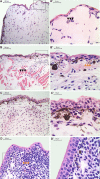Limb regeneration in a direct-developing terrestrial salamander, Bolitoglossa ramosi (Caudata: Plethodontidae): Limb regeneration in plethodontid salamanders
- PMID: 29299325
- PMCID: PMC5743783
- DOI: 10.1002/reg2.93
Limb regeneration in a direct-developing terrestrial salamander, Bolitoglossa ramosi (Caudata: Plethodontidae): Limb regeneration in plethodontid salamanders
Abstract
Appendage regeneration is one of the most compelling phenomena in regenerative biology and is extensively studied in axolotls and newts. However, the regenerative capacity in other families of salamanders remains poorly described. Here we characterize the limb regeneration process in Bolitoglossa ramosi, a direct-developing terrestrial salamander of the plethodontid family. We (1) describe the major morphological features at different stages of limb regeneration, (2) show that appendage regeneration in a terrestrial salamander varies from other amphibians and (3) show that limb regeneration in this species is considerably slower than in axolotls and newts (95 days post-amputation for complete regeneration) despite having a significantly smaller genome size than axolotls or newts.
Keywords: axolotl; genome size; newt; plethodontid; urodele.
Figures





References
-
- AmphibiaWeb (2017). AmphibiaWeb: information on amphibian biology and conservation. Available at https://amphibiaweb.org/ (accessed February 24, 2017).
-
- Arenas, C. M. , Gómez‐Molina, A. , & Delgado, J. P. (2015). Maintaining plethodontid salamanders in the laboratory for regeneration studies. Methods in Molecular Biology (Clifton, N.J.), 1290, 71–78. - PubMed
-
- Chippindale, P. T. , Bonett, R. M. , Baldwin, A. S. & Wiens, J. J. (2004). Phylogenetic evidence for a major reversal of life history evolution in plethodontid salamanders. Evolution, 58(12), 2809–2822. - PubMed
LinkOut - more resources
Full Text Sources
Other Literature Sources
